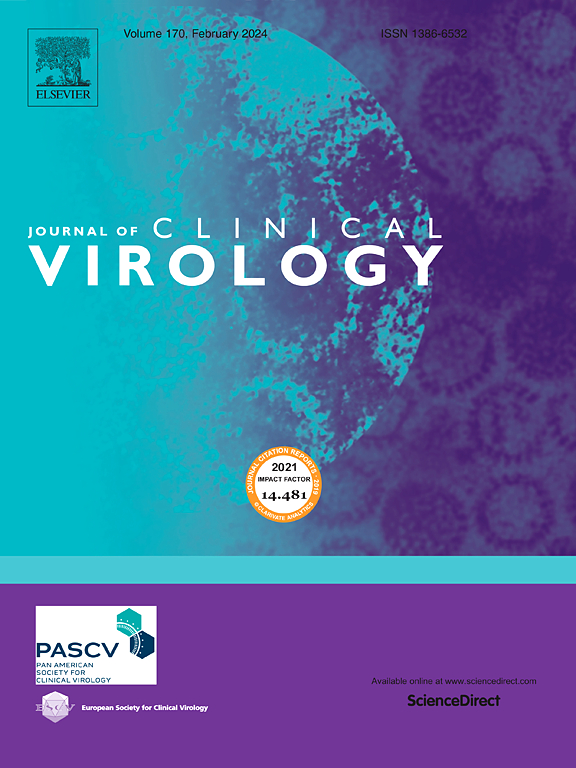2016 - 2019年新疫苗监测网络(NVSN)急性胃肠炎儿童中人腺病毒的流行情况
IF 3.4
3区 医学
Q2 VIROLOGY
引用次数: 0
摘要
背景:急性胃肠炎(AGE)是儿童发病和死亡的主要原因。然而,人类腺病毒(hav)造成的AGE负担尚未完全确定。目的了解美国儿童乙型肝炎的患病率及相关特征。研究设计:我们招募了2016年12月至2019年11月期间在7个儿科医疗中心住院和急诊科(ED)设置的年龄为18岁的AGE病例患者和11岁的健康对照患者。前瞻性地收集人口统计学、临床资料和粪便。使用多重分子板检测粪便的hav F40/41。对120例hadv阳性样本进行基因分型。结果2229例ED患者中有168例(8%)、2151例住院患者中有164例(8%)、2090例健康对照中有23例(1%)检出shadv。与hav阴性患者相比,hav阳性的AGE患者更可能是3岁,更可能报告腹泻(86%对67%)和脱水(43%对31%)(p <;0.0001,所有比较)。年龄在hadv阳性和阴性对照之间无显著差异。乙肝病毒阳性的AGE患者比乙肝病毒阴性的患者更不容易出现急性呼吸道症状(8% vs 18%, p <;0.0001)。最常见的hav基因型为F41 (n = 106, 88%)。其他潜在病原体在36%的hadv阳性AGE病例和43%的对照组中被检测到;最常见的是艰难梭菌。结论:在美国,shadv占住院和急诊科就诊年龄的8%,主要是幼儿。大多数病例为F41型,这可能为未来的疫苗开发提供信息。本文章由计算机程序翻译,如有差异,请以英文原文为准。
Prevalence of human adenovirus in children with acute gastroenteritis in the New Vaccine Surveillance Network (NVSN) from 2016 to 2019
Background
Acute gastroenteritis (AGE) is a leading cause of pediatric morbidity and mortality. However, the AGE burden from human adenoviruses (HAdV) is not fully defined.
Objective
To determine the prevalence and characteristics associated with HAdV in U.S. children.
Study design
We enrolled AGE case-patients <18 years of age in inpatient and emergency department (ED) settings and healthy controls <11 years of age between December 2016 and November 2019 at seven pediatric medical centers. Demographic and clinical data and stools were prospectively collected. Stools were tested for HAdV F40/41 using multiplex molecular panels. A subset of 120 HAdV-positive samples was genotyped.
Results
HAdV was detected in 168 (8 %) of 2229 ED patients, 164 (8 %) of 2151 inpatients, and 23 (1 %) of 2090 healthy controls. AGE case-patients positive for HAdV were more likely to be <3 years of age and more likely to report diarrhea (86 % vs 67 %) and dehydration (43 % vs 31 %) than HAdV-negative case-patients (p < 0.0001, all comparisons). Age did not differ significantly between HAdV-positive and negative controls. HAdV-positive AGE case-patients were less likely to have acute respiratory symptoms than HAdV-negative case-patients (8 % vs 18 %, p < 0.0001). The most frequently detected HAdV genotype was F41 (n = 106, 88 %). Other potential pathogens were detected in 36 % of HAdV-positive AGE case-patients and 43 % of controls; Clostridioides difficile was most common.
Conclusions
HAdV accounted for 8 % of medically attended AGE in both inpatient and ED settings in the U.S., primarily in young children. The majority of cases were type F41, which may inform future vaccine development.
求助全文
通过发布文献求助,成功后即可免费获取论文全文。
去求助
来源期刊

Journal of Clinical Virology
医学-病毒学
CiteScore
22.70
自引率
1.10%
发文量
149
审稿时长
24 days
期刊介绍:
The Journal of Clinical Virology, an esteemed international publication, serves as the official journal for both the Pan American Society for Clinical Virology and The European Society for Clinical Virology. Dedicated to advancing the understanding of human virology in clinical settings, the Journal of Clinical Virology focuses on disseminating research papers and reviews pertaining to the clinical aspects of virology. Its scope encompasses articles discussing diagnostic methodologies and virus-induced clinical conditions, with an emphasis on practicality and relevance to clinical practice.
The journal publishes on topics that include:
• new diagnostic technologies
• nucleic acid amplification and serologic testing
• targeted and metagenomic next-generation sequencing
• emerging pandemic viral threats
• respiratory viruses
• transplant viruses
• chronic viral infections
• cancer-associated viruses
• gastrointestinal viruses
• central nervous system viruses
• one health (excludes animal health)
 求助内容:
求助内容: 应助结果提醒方式:
应助结果提醒方式:


